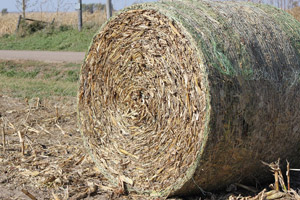Test Before Feeding Corn Stalk Bales
December 2015

Corn stalk bales will provide much needed feed this winter for many producers. If you’re one of them, be sure to feed them effectively.
Baled corn stalks are going to provide a lot of feed this winter. But before you feed those bales, find out what they have to offer nutritionally. Sample and test your bales as soon as possible so when snow gets deep or other feeds run out you will already know how to best feed your corn stalk bales.
Begin by testing the bales for protein and energy. You may be surprised at how variable the protein and energy content can be in corn stalk bales. I’ve seen protein as low as 3 percent and as high as 7 percent. Dry pregnant cows need 7 to 8 percent protein in their diet so high protein bales will need only a little protein to adequately care for the cows. But those 3 percent bales will need quite a bit of supplement to keep cows in good condition.
Use a protein supplement that is nearly all natural and is mostly rumen degradable. Maintenance-level forage diets need degradable protein for the rumen microbes, but remember that urea and other non-protein nitrogen sources aren’t used as well.
Many bales have pretty good total digestible nutrients (TDN) levels, nearly 60 percent. Cows fed these bales should do very well up until calving with just corn stalk bales and adequate protein supplement. However, stalks rained on before baling can be below 50 percent TDN. Cows fed these lower quality bales will need some extra energy, too.
If your bales came from stressed stalks, like from drought or hail, also get a nitrate test to be sure they are safe.
Good testing of corn stalk bales can help make them a nutritious and safe feed.
Bruce Anderson
Nebraska Extension Forage Specialist